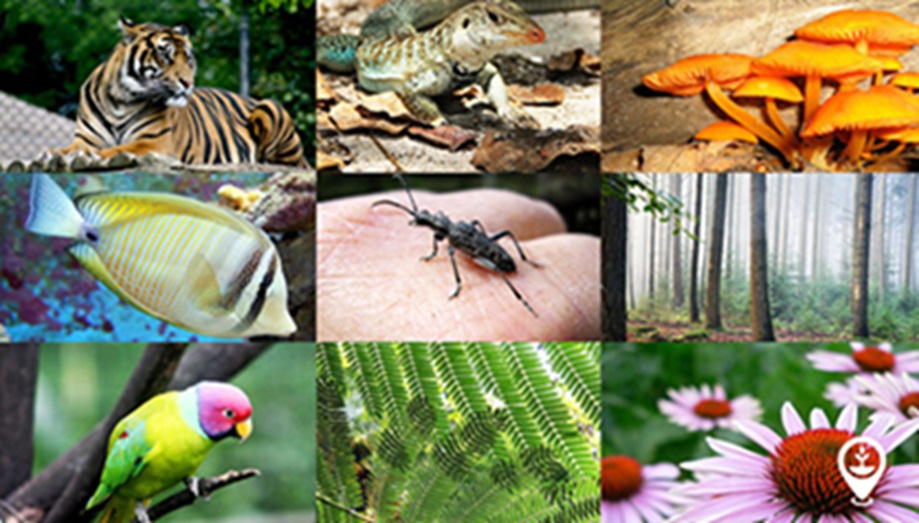Biodiversity is essential for local economies in India, supporting agriculture, tourism, fisheries, and medicinal sectors. This paper examines the role of biodiversity, showcasing successful examples like Sikkim’s organic farming and Kerala’s backwater tourism. It also addresses challenges such as deforestation in the Western Ghats, overfishing, and climate change. Emphasizing the need for effective conservation strategies, the paper advocates for protected areas, sustainable practices, and community involvement to safeguard biodiversity and ensure economic stability.
Introduction
Biodiversity refers to the variety of life forms in a given area, including animals, plants, fungi, humans and microorganisms. These diverse species interact within ecosystems to maintain natural balance and support fundamental needs like food, clean water, medicine, and shelter (World Wide Fund,n.d.). However, increasing human activities and resource consumption disrupt these ecosystems and threaten biodiversity. Renowned for its vast diversity, India ranks ninth globally in plant species richness and contains two of the world’s 25 biodiversity hotspots. The country is also a significant source of key crop species and domesticated plants. With about 91,000 animal species, India’s biodiversity is vital for food security, medicinal resources, and tourism, making it crucial to protect this natural wealth.
Role of Biodiversity in Local Economies
Agriculture and Food Security: Biodiversity is vital for agriculture and food security. Insects, particularly bees, are crucial for crop pollination, enhancing yields of fruits and vegetables. In India, honeybee shortages affect productivity, highlighting the need for increased apiculture and improved management. Natural pest control by predatory insects and birds reduces reliance on pesticides, while diverse ecosystems support these beneficial species, improving crop health. Soil fertility relies on organisms like earthworms and microbes, which decompose organic matter and enhance nutrient availability. Organic farming and conservation practices are essential in India to sustain soil health and agricultural productivity.
Tourism and Recreation: Tourism significantly impacts India’s economy, contributing 9.2% to the GDP and employing millions. The sector is expected to grow substantially, reaching ₹32.05 lakh crore by 2028. Ecotourism, focusing on environmental sustainability and local community benefits, is crucial. In Athirappilly-Vazhachal, tourism boosts the local economy but also poses threats to biodiversity due to unregulated visitor influx. The Kerala Forest Department has implemented management strategies, including participatory forest management and service charges, to balance tourism benefits with conservation needs, involving local communities and improving infrastructure while addressing socio-environmental issues.
Fisheries and Aquaculture: India is a leading fish producer, contributing 7.58% to global production and 1.24% to India’s GVA. The sector has shown impressive growth, with fish production at 137.58 lakh metric tons in 2018-19. Marine and inland fisheries support food security, nutrition, and livelihoods for millions, particularly rural populations. With a vast coastline and diverse inland water resources, fisheries and aquaculture employ 25 million fishers and fish farmers. Sustained policy and financial support are crucial for the sector’s sustainable and inclusive development.
Medicinal Resources: The Ayush sector plays a pivotal role in local economies by creating jobs, with over 5.56 lakh opportunities anticipated. Investments of INR 9,000 crore spur economic activity across sectors like FMCG and pharmaceuticals. The growth of startups and MSMEs in Ayush fosters entrepreneurship and local business development. Increased demand for traditional medicines supports local agriculture and resource management, while expanded healthcare services enhance public health and reduce costs. Overall, the sector boosts economic resilience and community development.
Case Studies – Positive Developments
- Organic Farming and Eco-tourism in Sikkim
Sikkim has achieved remarkable success in promoting organic farming and eco-tourism, setting an example for sustainable development in India. The state’s commitment to 100% organic farming has yielded numerous benefits. Environmentally, it has led to healthier soil and water by eliminating chemical fertilizers and pesticides. Economically, farmers benefit from higher market values for organic produce and increased export potential. Socially, the local communities enjoy improved health and have adopted sustainable farming practices.
Sikkim’s eco-tourism initiatives focus on preserving natural landscapes and biodiversity while benefiting local communities. This approach has resulted in environmental conservation, economic growth through tourism revenue, and cultural preservation. Tourists visiting Sikkim can experience organic villages and explore protected areas such as Khangchendzonga National Park, a UNESCO World Heritage site, which offers unique insights into the region’s ecological and cultural heritage.
- Backwater Tourism and Wetland Preservation in Kerala
Kerala’s backwater tourism is a prime example of how natural resources can be leveraged for economic https://whc.unesco.org/en/list/1513/and community benefits. The intricate network of lakes, canals, and rivers attracts numerous tourists, contributing significantly to Kerala’s GDP and creating employment opportunities in the hospitality and tourism sectors. Local communities benefit through houseboat tours, homestays, and the sale of local crafts. Emphasis on eco-friendly tourism practices helps minimize pollution and conserve the water ecosystem.
Wetland preservation efforts in Kerala further demonstrate the state’s commitment to sustainable development. Wetlands like Vembanad Lake and Kumarakom Bird Sanctuary are crucial for biodiversity, supporting various species of flora and fauna, including migratory birds and aquatic life. These wetlands also play a vital role in water management, flood control, and groundwater recharge. Community engagement in conservation initiatives ensures sustainable use of wetland resources, promoting long-term environmental health and resilience.
Case Studies – Adverse Outcomes
- Impact of Deforestation in the Western Ghats
The Western Ghats, a critical global biodiversity hotspot, has experienced significant ecological damage due to deforestation. Recent analyses reveal a 5% loss in evergreen forest cover, coupled with a 4.5% increase in built-up areas and a 9% rise in agricultural land. Fragmentation studies show that only 25% of the forest area remains as interior forest, reflecting severe fragmentation pressures. These changes threaten local biodiversity and disrupt ecological balance. The Western Ghats Spatial Decision Support System (WGSDSS) developed by the Indian Institute of Science aims to improve governance and management, but the ongoing ecological stress highlights the urgent need for more effective conservation strategies.
- Excessive Fishing Activity in Coastal Regions
Overfishing in India’s coastal regions poses a grave threat to both marine ecosystems and local economies. If current fishing practices continue, the depletion of fish stocks will have devastating environmental and economic impacts on coastal communities. The WTO agreement seeks to mitigate the damage caused by subsidized illegal, unreported, and unregulated (IUU) fishing, which exacerbates overfishing problems. Immediate action is critical, as recovery from overfishing is often impossible once stocks are depleted.
Challenges and Threats in India
- Habitat Destruction and Its Impact on Biodiversity in India
Deforestation and urbanization are significant causes of habitat destruction, leading to biodiversity loss. Deforestation results in habitat loss and fragmentation, isolating wildlife populations and reducing genetic diversity. Urbanization fragments habitats and displaces wildlife, particularly in peri-urban areas where natural landscapes are converted into urban zones. The Sundarbans, home to the Bengal tiger, face severe deforestation due to agricultural expansion and urban development. This habitat loss and fragmentation stress the tiger population, reduce prey availability, and increase human-tiger conflicts.
- Climate Change
Climate change in India significantly impacts agriculture, water resources, and ecosystems. Rising temperatures and altered precipitation patterns reduce crop yields and water availability, exacerbating soil degradation. Water scarcity results from changing river flows and increased evaporation rates, threatening both ecosystems and local communities. For example, the Sundarbans mangrove ecosystem faces severe vulnerabilities due to climate change. Rising sea levels and increased salinity endanger the Bengal tiger and various fish species. Frequent cyclones and flooding exacerbate habitat loss, posing challenges for local communities. Adaptation strategies, such as mangrove restoration and disaster management, are essential to enhance resilience.
- Overexploitation of Resources
Overfishing, poaching, and unsustainable practices threaten India’s biodiversity. Overfishing depletes fish stocks, disrupts ecosystems, and impacts livelihoods. Poaching for illegal trade endangers species and disrupts ecological balance. Unsustainable practices, like habitat destruction, compound these issues. For instance, overexploitation has severe consequences for fish populations and wildlife trade. Depletion of fish stocks reduces marine biodiversity and threatens food security for coastal communities. The illegal wildlife trade undermines conservation and leads to the decline of endangered species. Stricter regulations, sustainable fishing, and anti-poaching efforts are crucial to mitigating these impacts.
Conservation Strategies in India
- Protected Areas: India has a network of 700 Protected Areas, including National Parks, Wildlife Sanctuaries, and Conservation Reserves, supported by the Integrated Development of Wildlife Habitats (IDWH) scheme. The scheme focuses on supporting these areas, protecting wildlife outside them, and recovering critically endangered species such as the Greater Adjutant, Gangetic Dolphin, Wild Water Buffalo, Vultures, and Snow Leopard. The National Wildlife Action Plan (2017-2031) guides development projects around these areas. The Ministry’s eco-tourism guidelines promote nature tourism and conservation awareness, while the Swachch Bharat Mission aims to keep Protected Areas plastic-free and clean. Human-wildlife conflict mitigation includes compensation for losses, resource enrichment, and innovative population management methods. Internationally, India collaborates with the USA on wildlife conservation and trafficking issues, showcasing its commitment to preserving biodiversity.
- Sustainable Practices: Sustainable practices are exemplified by Sikkim’s and Odisha’s approaches to environmental management. Sikkim, as India’s first fully organic state, implements sustainable agriculture by avoiding synthetic fertilizers and pesticides, which enhances soil health, biodiversity, and farmers’ economic returns. This commitment is supported by state policies that focus on organic farming, crop management, irrigation, and post-harvest practices. In Odisha, sustainable forest management is achieved through community-managed forests, where local communities are actively involved in conservation and management. This participatory approach ensures biodiversity preservation, provides livelihoods, and promotes responsible forest resource use. Both states illustrate the effective integration of environmental conservation with community engagement and sustainable practices.
- Community Involvement: Community involvement is crucial for effective conservation, as demonstrated by the initiatives in India. The Joint Forest Management (JFM) program engages local communities in the management and protection of forests, allowing them to share in the benefits derived from sustainable forest use. This approach has led to improved forest cover, enhanced biodiversity, and increased incomes for local people. Similarly, the Nilgiri Biosphere Reserve incorporates community participation in eco-development and sustainable agricultural practices, which has contributed to the protection of endangered species like the Nilgiri tahr and lion-tailed macaque while promoting sustainable livelihoods. Both examples highlight the success of involving local communities in conservation efforts, ensuring that strategies are culturally appropriate and effective in achieving long-term environmental goals.
Conclusion
Biodiversity is a cornerstone of India’s local economies, providing essential resources and services that sustain livelihoods and promote economic growth. The success stories of Sikkim and Kerala demonstrate how sustainable practices and eco-tourism can enhance both environmental conservation and community well-being. However, the threats posed by habitat destruction, climate change, and overexploitation highlight the urgent need for stronger conservation efforts. By adopting sustainable practices, involving local communities, and enforcing effective policies, India can preserve its rich biodiversity, ensuring long-term economic and ecological health. Protecting biodiversity is not just an environmental imperative but also a pathway to securing the future prosperity of India’s local economies.
Title image courtesy: Eco Matcher
Disclaimer: The views and opinions expressed by the author do not necessarily reflect the views of the Government of India and Defence Research and Studies

REFERENCES
- World Wildlife Fund. (n.d.). What is biodiversity? World Wildlife Fund. Retrieved July 24, 2024, from https://www.worldwildlife.org/pages/what-is biodiversity#:~:text=Biodiversity%20supports%20everything%20in%20nature,of%20ecosystems%20and%20losing%20biodiversity.
- Vikaspedia. (n.d.). Honeybee and crop pollination. Retrieved July 24, 2024, from https://vikaspedia.in/agriculture/best-practices/sustainable-agriculture/biodiversity/honeybee-and-crop-pollination#:~:text=Pollination%20plays%20a%20vital%20role,rice%20reproduce%20without%20insect%20pollination.
- National Fisheries Development Board. (n.d.). About Indian fisheries. Government of India, Ministry of Fisheries, Animal Husbandry and Dairying. Retrieved July 27, 2024, from https://nfdb.gov.in/welcome/about_indian_fisheries#:~:text=Fisheries%20and%20aquaculture%20remain%20an,number%20along%20the%20value%20chain
- Strategic Investment Research Unit. (2022, May 2). Economic dimensions of an emergent Ayush sector in India. Invest India. https://www.investindia.gov.in/team-india-blogs/economic-dimensions-emergent-ayush-sector-india#:~:text=The%20Ayush%20industry%20is%20booming,of%20%24%2020.6%20Bn%20in%202022
- The United India. (2024, June 22). Silent suffering: How deforestation in India impacts wildlife? The United India. https://theunitedindian.com/news/blog?impact-of-deforestation-in-India-on-wildlife&b=272&c=1
- The United India. (2023, December 12). From tigers to trees: Navigating through the scenario of loss of biodiversity in India. The Tapestry of Life. https://theunitedindian.com/news/blog?loss-of-biodiversity-in-India&b=136&c=1#:~:text=Deforestation%20and%20Habitat%20Destruction%20%3A%20One,unique%20ecosystems%20face%20irreversible%20damage.
- Ministry of Environment, Forest and Climate Change. (n.d.). Wildlife. Government of India.https://moef.gov.in/wildlife
- Government of Sikkim. (2024). Food Security and Agriculture Development Department. Retrieved from https://sikkim.gov.in/departments/food-security-and-agriculture-development-department
- Odisha State Forest Headquarters. (2024). Working Plan. Retrieved from https://odishaforest.in/forest-management/working-plan
- Invest India. (2021, November 11). India goes green: The Sikkim model of sustainable development. Strategic Investment Research Unit (SIRU). https://www.investindia.gov.in/team-india-blogs/india-goes-green-sikkim-model-sustainable-development
- Ministry of Environment, Forest and Climate Change. (n.d.). Wildlife conservation. Retrieved from https://moef.gov.in/wildlife#:~:text=Integrated%20Development%20of%20Wildlife%20Habitats(IDWH)%3A%20At%20present%20India,Reserves%20and%204%20Community%20Reserves
- Ministry of Environment, Forest and Climate Change. (n.d.). Forest conservation. Government of India.https://moef.gov.in/forest#:~:text=Most%20of%20the%20State%20Forest,of%20hectares%20of%20degraded%20forestlands









